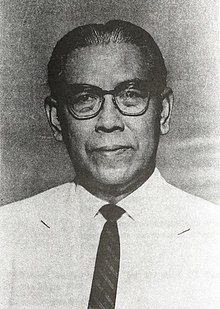Sanusi Hardjadinata | |
|---|---|
 Official portrait, c. 1957 | |
| 2nd Chairman of the Indonesian Democratic Party | |
| In office 20 February 1975 – 16 October 1980 | |
| Preceded by | Mohammad Isnaeni |
| Succeeded by | Sunawar Sukowati |
| 6th Governor of West Java | |
| In office 29 June 1951 – 9 July 1957 | |
| Preceded by | Raden Sewaka |
| Succeeded by | Ipik Gandamana |
| Ministerial offices | |
| 1967–1968 | Minister of Education |
| 1966–1967 | Minister of Industry and Development |
| 1957–1959 | Minister of Home Affairs |
| Legislative offices | |
| 1975–1978 | Member of the Supreme Advisory Council (DPA) |
| 1956–1959 | Member of the Constitutional Assembly from West Java |
| Other offices | |
| 1964–1966 | Rector of Padjadjaran University (UNPAD) |
| 1959–1964 | Indonesian Ambassador to the United Arab Republic |
| Personal details | |
| Born | Samaun 24 June 1914 Garut, Dutch East Indies |
| Died | 12 December 1995 (aged 81) Jakarta, Indonesia |
| Resting place | Sirnaraga Public Cemetery |
| Political party | |
| Spouses |
|
| Children | 8 |
| Education | Hollandsche Indische Kweekschool (HIK) |
| Occupation | |
Mohammad Sanusi Hardjadinata (born as Samaun; 24 June 1914 – 12 December 1995) was an Indonesian politician who served as the second chairman of the Indonesian Democratic Party (PDI) from 1975 until 1980. Prior to serving as party chairman, held numerous positions during the presidencies of Sukarno and Suharto, including as governor of West Java, member of the Constitutional Assembly, and cabinet minister in the Djuanda and Ampera cabinets.
Sanusi was born to a well-off aristocratic family in Garut, Dutch East Indies (now Indonesia). He was educated at a Dutch school, and worked as a teacher after graduating. Following the proclamation of Indonesian Independence, he was appointed the vice resident of Priangan. In April 1948, he was arrested and detained by Dutch authorities for his opposition to the creation of the Dutch-backed State of Pasundan. He was released in July 1948, and he left for Yogyakarta and later Madiun. There, he helped rebuild the city after the failed communist uprising which occurred a few months earlier. In 1949, he was appointed acting Resident of Priangan, and during the transition from a federal state to a unitary one, he served as the Pasundan state's head of education. In 1951, Sanusi was appointed governor of West Java, though his appointment was initially challenged by the provincial assembly. As governor, he helped organize the Bandung Conference and established Padjadjaran University in 1957.
In 1955, he was elected a member of the Constitutional Assembly, and participated in constitutional debates up until the assembly's dissolution in 1959. In April 1957, he was appointed Minister of Home Affairs by Prime Minister Djuanda Kartawidjaja. Following President Sukarno's 1959 Decree, Sanusi was dismissed as minister, and was appointed Indonesia's ambassador to Egypt instead. He returned to Indonesia in 1964, and was appointed rector of Padjadjaran University. Following the transition to the New Order, Sanusi was appointed as a cabinet minister in the Ampera and the Revised Ampera cabinets under president Suharto. In 1975, he was appointed the Chairman of the Indonesian Democratic Party, replacing Mohammad Isnaeni. Under his leadership, the party suffered from a number of internal conflicts, and he resigned as chairman in 1980. After his resignation from the party, he became involved with the Petition of Fifty. Sanusi died on 12 December 1995, after suffering from complications in his lungs, kidneys, and liver. His body was interred at the Sirnaraga Public Cemetery in Bandung.
© MMXXIII Rich X Search. We shall prevail. All rights reserved. Rich X Search
